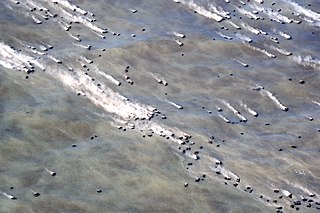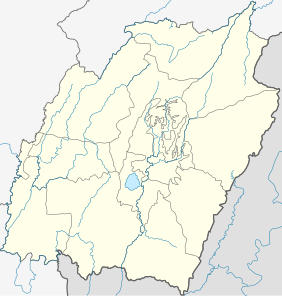 W
WA floating island is a mass of floating aquatic plants, mud, and peat ranging in thickness from several centimeters to a few meters. Floating islands are a common natural phenomenon that are found in many parts of the world. They exist less commonly as an artificial phenomenon. Floating islands are generally found on marshlands, lakes, and similar wetland locations, and can be many hectares in size.
 W
WThe Floating islands of Bingöl are mass of floating aquatic plants in the form of islands on a lake in Bingöl Province, eastern Turkey. The formation is a registered natural monument of the country.
 W
WProject Habakkuk or Habbakuk was a plan by the British during the Second World War to construct an aircraft carrier out of pykrete for use against German U-boats in the mid-Atlantic, which were beyond the flight range of land-based planes at that time. The idea came from Geoffrey Pyke, who worked for Combined Operations Headquarters. After promising scale tests and the creation of a prototype on a lake in Alberta, Canada, the project was shelved due to rising costs, added requirements, and the availability of longer-range aircraft and escort carriers which closed the Mid-Atlantic gap the project was intended to address.
 W
WThe Keibul Lamjao National Park is a national park in the Bishnupur district of the state of Manipur in India. It is 40 km2 (15.4 sq mi) in area, the only floating park in the world, located in North East India, and an integral part of Loktak Lake.
 W
WThe 2012 Kermadec Islands eruption was a major undersea volcanic eruption that was produced by the previously little-known Havre Seamount near the L'Esperance and L'Havre Rocks in the Kermadec Islands of New Zealand. The large volume of low density pumice produced by the eruption accumulated as a large area of floating pumice, a pumice raft, that was originally covering a surface of 400 square kilometres, spread to a continuous float of between 19,000 and 26,000 square kilometres and within three months dispersed to an area of more than twice the size of New Zealand.
 W
WA lava balloon is a gas-filled bubble of lava that floats on the sea surface. It can be up to several metres in size. When it emerges from the sea, it is usually hot and often steaming. After floating for some time it fills with water and sinks again.
 W
WPhumdis are a series of floating islands, exclusive to the Loktak Lake in Manipur state, in northeastern India. They cover a substantial part of the lake area and are heterogeneous masses of vegetation, soil and organic matter, in different stages of decay. The largest single mass of phumdi is in the southeastern part of the lake, covering an area of 40 km2 (15.4 sq mi). This mass constitutes the world’s largest floating park, named Keibul Lamjao National Park. The park was formed to preserve the endangered Eld's deer subspecies, called sangai in the Meitei language, indigenous to this area.
 W
WA pumice raft is a floating raft of pumice created by some eruptions of submarine volcanoes or coastal subaerial volcanoes.
 W
WSebitseom (세빛섬), also known as Sebit islets, are artificial islands in the Han River, Seoul, South Korea. It was built at the suggestion of Kim Eun-sung in 2006. Seoul City made this island by Build-Transfer-Operate (BTO). It has 3 islands: Gavit, Chavit, and Solvit. Yevit is part of Sebitseom, but is not an island itself, but rather, it's an on-land multimedia art gallery complementing the three floating islands.
 W
WSpiral Island is the name of a floating artificial island built in Mexico by British artist Richart "Reishee" Sowa. It was destroyed by Hurricane Emily in 2005; a replacement, Joyxee Island, has been open for tours since 2008.
 W
WThe Uru or Uros are an indigenous people of Peru and Bolivia. They live on an approximate and still growing 120 self-fashioned floating islands in Lake Titicaca near Puno. They form three main groups: the Uru-Chipaya, Uru-Murato, and Uru-Iruito. The Uru-Iruito still inhabit the Bolivian side of Lake Titicaca and the Desaguadero River.